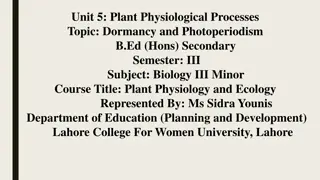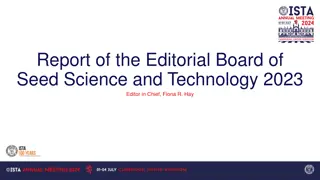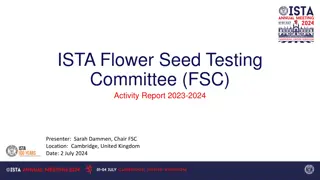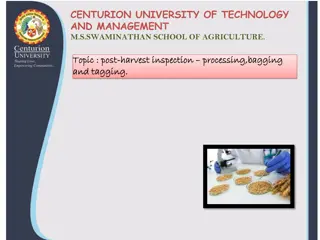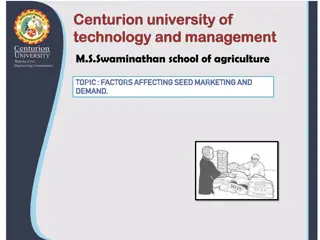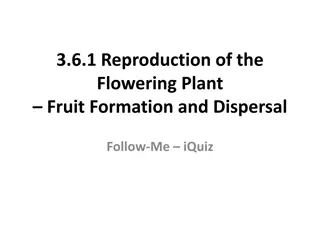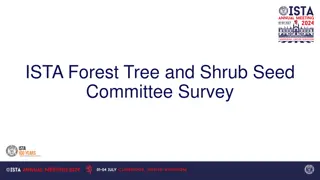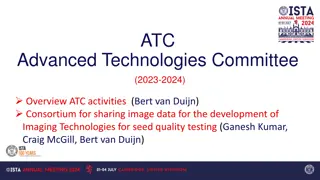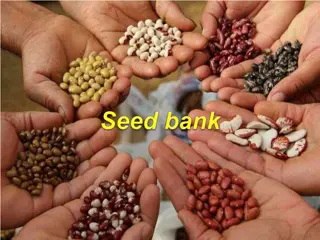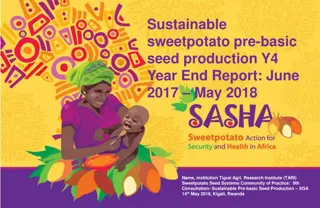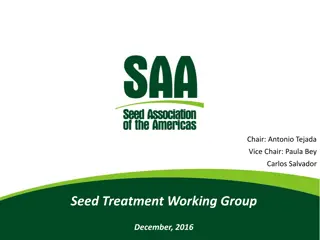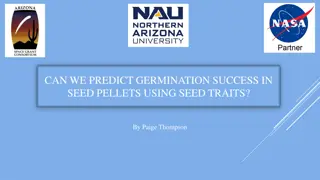Understanding Seed Viability Testing and Standards
Seed viability is crucial for successful germination and plant growth. Various tests like tetrazolium, germination, cut, X-ray analysis, and more are used to assess seed viability. Preconditioning seeds, seed hydration, and seed staining are important steps in the tetrazolium test. Evaluating seeds based on staining patterns and conducting germination tests provide valuable information on seed quality. Proper substratum, moisture, temperature, and light conditions are necessary for successful germination.
Uploaded on Jul 18, 2024 | 0 Views
Download Presentation

Please find below an Image/Link to download the presentation.
The content on the website is provided AS IS for your information and personal use only. It may not be sold, licensed, or shared on other websites without obtaining consent from the author. Download presentation by click this link. If you encounter any issues during the download, it is possible that the publisher has removed the file from their server.
E N D
Presentation Transcript
CENTURION UNIVERSITY OF TECHNOLOGY AND MANAGEMENT M.S.SWAMINATHAN SCHOOL OF AGRICULTURE. Topic : quick viability test and seed standards. Topic : quick viability test and seed standards.
SEED VIABILITY SEED VIABILITY- Seed viability refers to the capability of a seed to germinate and produce a normal seedling. The viability of the seed accession is a measure of how many seeds are alive and could develop into plants which will reproduce themselves, when given the appropriate conditions. SEED VIABILITY TESTS Tetrazolium test ( Tz ) Germination test Cut test X-ray analysis Spectral imaging . Ferric Chloride Test for Mechanical Damage . Indoxyl Acetate Test for Seed Coat Damage. Noninvasive diagnosis of seed viability using infrared thermography.
TETRAZOLIUM TEST TETRAZOLIUM TEST (George Lakon in 1942) OBJECTIVE: Rapid assessment of viability. PRINCIPLE: A colorless tetrazolium solution is used as an indicator producing in living cells a red, stable and non-diffusible substance, named Formazan. Thus, it s possible to distinguish the red colored living tissues from the colorless dead ones and the seeds are classified into viable and non viable seed classes. PRECONDITIONING OF SEED BEFORE TETRAZOLIUM (Tz) TEST Preconditioing of seeds before Tetrazolium (Tz) test no moistening or preparation required (small seeded legumes with soft coats). Seeds directly placed in Tz solution in case of peas and beans bisect longitudinally before placing in Tz solution. Eg: The seed coat may be removed e.g. cucurbits The seed coat may be scratched above embryo e.g. lettuce METHODOLOGY SEED HYDRATION It is done by soaking seeds in water for a specific period of time . This is done to active hydrolytic enzyme (dehydrogenase) and stimulate respiration. CUTTING OR PUNCTURING OF SEED This is done to allow the penetration of Tz solution into internal tissues.
STAINING OF SEEDS Staining of seeds: It is done by soaking seeds in Tz solution for a specific period of time to allow staining of viable tissue in the seed. Tz is used @ 0.1 or 1.0 % solution, at 30-35 C temperature for 24- 48 hours at pH of 6-8. EVALUATION OF SEED Evaluation of seeds evaluated according to staining pattern. GERMINATION TEST OBJECTIVE: To gain information about the field planting value of the seed lot. GERMINATION : Germination in a laboratory test refer to the emergence from the seed embryo of those essential structures which for the kind or seed being tested indicate its ability to develop into a normal plant under favourable condition) PHASES OF GERMINATION Imbibition phase (Rapid uptake of water) Active metabolism (Major metabolic pathways affected are respiration, protein synthesis, DNA replication, RNA synthesis etc.) Cell expansion and seedling protrusion. GENERAL REQUIREMENT FOR GERMINATION SUBSTRATUM Suitable substratum : Paper, sand or soil . Adequate moisture/ water : pH 6-7.5,. Favourable temperature : as per crop . Light : Required for germination in some of the crops like lettuce etc.
PROCEDURE From working sample take 400 seed at random. Method Between Paper/ Top Paper / sand Plant seed as 100 4R, 50 8R, 25 16R Provide temperature or light and humidity as recommended. Germination count(1st and final as per specie) THE CUT TEST The cut test is simple and easily executed. Viability is determined by cutting the seed open and examining the contents. In particular, the seed embryo must appear intact and healthy if the seed is to go on and germinate. In addition, the endosperm must appear clean and firm. X-RAY ANALYSIS X-ray radiography is a valuable tool to supplement laboratory tests , provide additional information about the seed lot quality along with the internal detail/structure of the seed. X-ray analysis can be a very efficient and non-destructive method of assessing seed quality. A good x-ray image will reveal details of seed fill, insect infestation and also size or absence of the embryo.
Seed standards In order to conform to seed certification standards, seeds must meet certain prescribed requirements Minimum % of pure seeds and maximum permissible limits for inert matter. Maximum permissible limits for other crop seeds. Maximum permissible limits for objectionable weed seeds and seeds infected by seed- borne diseases to ensure good seed health. Minimum percentage of germination. Maximum permissible limits for moisture content for the safe storage of seeds.


